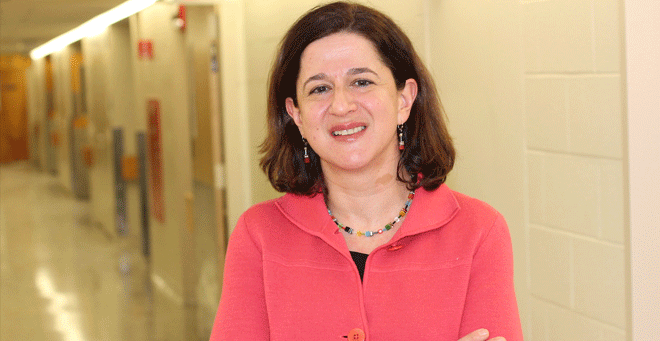 |
|
| Roula N. Choueiri, MD |
Roula N. Choueiri, MD, a pediatrician at UMass Medical School, has developed a rapid intervention screening test for autism spectrum disorder (ASD) in toddlers, designed to improve early identification and access to treatment. A study about its development will be published in the August issue of The Journal of Pediatrics and is available online in advance of publication.
“We believe that the use of this tool will greatly expand effective autism spectrum disorder screening, which would lead to better and earlier identification of autism and, thus, earlier access to important treatment,” said, Dr. Choueiri, associate professor of pediatrics, chief of the Division of Developmental and Behavioral Pediatrics and principal investigator of the study.
The Rapid Intervention Screening Test for Autism in Toddlers (RITA-T) will be used to assess at-risk toddlers in general pediatric and early intervention settings. The interactive level 2 screening measure is given to toddlers 12 to 36 months of age after a universal or level 1 screen is positive or whenever there are concerns about developmental delays.
According to the Centers for Disease Control and Prevention, one in 68 children has been identified as having ASD as of 2010. Despite the fact that early signs of ASD can be seen as early as 12 months, on average, children identified with ASD are still diagnosed around age 4.
The American Academy of Pediatrics recommends that children be screened for ASD at 18 and 24 months. Current screening methods include the Modified Checklist for Autism in Toddlers (MCHAT), a level 1 assessment consisting of a parental and provider questionnaire. While it is an excellent tool for identifying developmental delays, it produces a high number of false-positive results for ASD. Currently only one level 2 screening is clinically available—the Screening Tool for Autism in Two-Year-Olds (STAT); however, the STAT is 20 minutes long, may miss milder forms of ASD in children 2 to 3 years old and its properties are weaker in children younger than 2 years. The RITA-T administration and scoring takes less than 10 minutes.
Currently, ASD diagnosticians are overwhelmed with referrals of toddlers who have only a positive level 1 result or who exhibit possible symptoms of ASD. The administration of the RITA-T may help identify those at a real ASD risk, Choueiri said. Early Intervention for ASD is crucial for improved skills and development, and may change the course of the disorder, she said.
In The Journal of Pediatrics article, Sheldon Wagner, PhD, director of Behavior, Development and Educational Services Inc., and Choueiri, a neurodevelopmental disabilities pediatrician, write that the RITA-T, through a series of interactive play-type tests, showed a high sensitivity and specificity when used to screen children 18 to 36 months old in general pediatric and early intervention settings.
For the study, 61 toddlers between the ages of 18 and 36 months participated in nine interactive, play-type activities designed to evaluate developmental constructs known to represent early signs of ASD: joint attention, social awareness, reaction to emotions, awareness of human agency and some fundamental cognitive skills.
For example, one portion of the test considers the toddler’s reaction to a parent’s “feigned neutral or sad” emotions. Another evaluates the toddler’s response to being interrupted as he or she explores an object, such as a toy phone.
To conduct the study, Choueiri and Wagner recruited two groups of toddlers: one group with no developmental concerns raised by a physician or therapists and the other group referred by clinicians because of concerns about either developmental delays or ASD.
Choueiri plans to further her study and collect additional data on how RITA-T functions in different settings by working with Worcester-based early intervention programs and pediatric clinics.
Learn more about how the test was developed and how it will be used in this video.
Related link on UMassMedNow:
Expert’s Corner: Roula Choueiri, MD, on detecting autism spectrum disorders